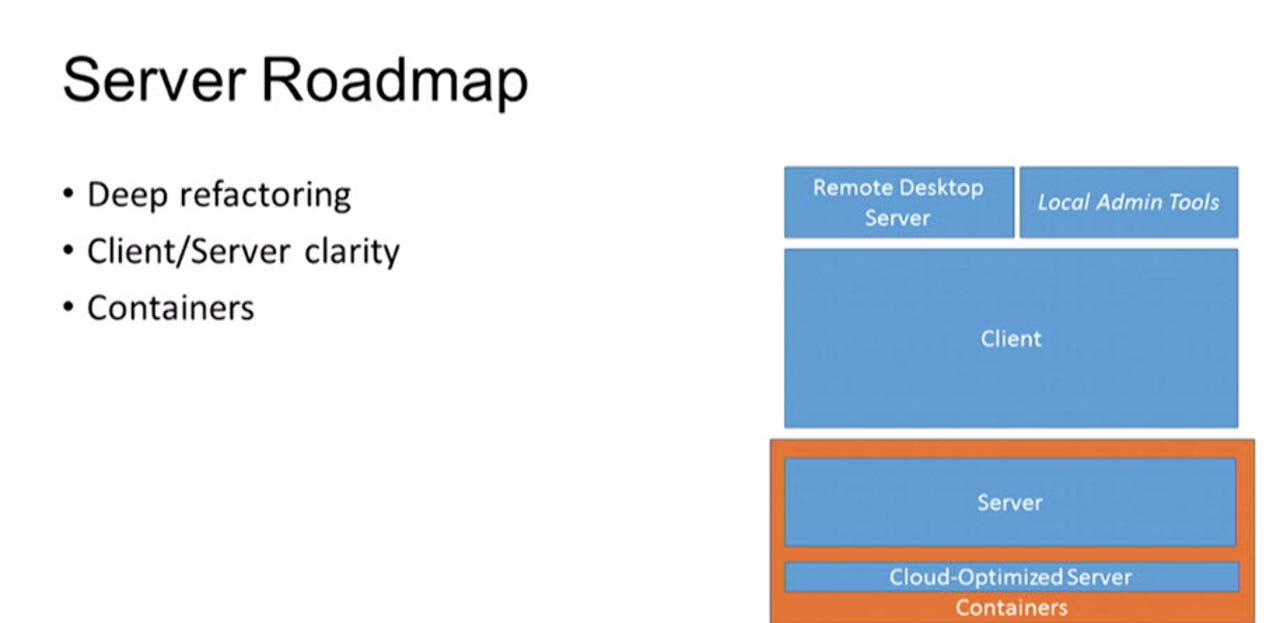What's next for Microsoft's Windows Server 2016

Beyond acknowledging that Microsoft doesn't plan to deliver the next version of Windows Server until some time in 2016, company officials haven't said much lately about Microsoft's future plans for Windows Server.

That silence was broken last week during Microsoft's TechDays Online event when Distinguished Engineer and Lead Architect for Windows Server and System Center Datacenter Jeffrey Snover talked a bit more about Microsoft's thinking regarding Windows Server Next, AKA Windows Server 2016.
I read Redmond Magazine's write-up of Snover's 30-minute talk on Microsoft's "Server Journey," and then watched the Channel 9 recording of it myself.
Snover said Microsoft is "deeply refactoring" the next version of Windows Server so that it will be a "cloud-optimized server." What does that mean, exactly? Isn't Windows Server already cloud-optimized, given it's what Azure itself runs on?
Snover said Microsoft is building a server that will include two "largely compatible" application profiles. One will target the existing set of Windows Server application programming interfaces (APIs) and the second, just the APIs that are "cloud optimized." Users will be able to "take just the components you need," he said.
This is basically in keeping with what General Manager of Windows Server Mike Neil told me back in October at Tech Ed Europe. Neil said that with the next release of Windows Server, Microsoft was "taking learnings from Azure and making them available to a broader set of customers." Neil said Microsoft would be extending all of the "software-defined stuff," including networking and management features that were built into Windows Server 2012 and Server 2012 R2 and extending those technologies by working with partners in those ecosystems.
Neil emphasized that the "learnings" of the Windows Server and Azure teams go both ways. A lot of the investments Microsoft has made in Server with Hyper-V are moving to the cloud. A lot of the storage work the Azure team has done is now showing up in things like Microsoft's Azure-in-a-box Cloud Platform System.
"How do you bring the learnings from super high scale with Azure and bring it down? This stuff today is custom. Our customers want something turnkey from service providers, systems integrators, so they can layer their services on top of this," Neil said. "We are looking forward to blurring the lines more between on-premises and cloud."
Last week, Snover also said Microsoft would be working to further clarify what's a client vs. what's a server with the next release of Windows Server. He said that users will be able to install a client on top of server. As Microsoft execs promised recently, Microsoft will be adding container support for its server and cloud-optimized server flavors of Windows Server 2016.
"We will have two flavors of compute containers: One for application compatibility," meaning server in a container, and also "containers optimized for the cloud" as part of the cloud-optimized server, Snover said. He said Microsoft will share more details on these pieces at its upcoming Build 2015 and Ignite conferences in late April and early May, respectively.
Microsoft officials said last October that the Docker Engine open-source run time for building, running and orchestrating containers will work with the next version of Windows Server. A new Docker Engine for Windows Server will be developed as a Docker open-source project, with Microsoft participating as an active community member.
At the same time, Microsoft also is working on evolving its Azure platform-as-a-service (PaaS) architecture, moving to more of a microservices model.
Microsoft officials said recently to expect the next public preview of Windows Server 2016 some time in the spring of 2015. I'm assuming we might also see the second public preview of System Center Next around that same time, given Microsoft made available the first public System Center Next preview on October 1, 2014 -- the same day it made available the first (and so far only) public preview of Windows Server 2016.
The Windows Server and Systems Center teams are becoming more integrated and doing more joint planning these days, Snover said. He also noted that inside the Server/System Center org, Microsoft will be doing more internal "open sourcing," allowing developers to see and check in/out code across the platforms.
Snover advised IT pros to make sure they "buy the right stuff" in advance of Windows Server 2016's arrival. They should make sure to buy network interface controllers (NICs) that support remote direct memory access (RDMA), lighting up SMB3; look for servers with trusted platform modules, once they become more widely available; and guarantee they're set up to do full remote management, with PowerShell support for automation in order to be prepared for what's next.